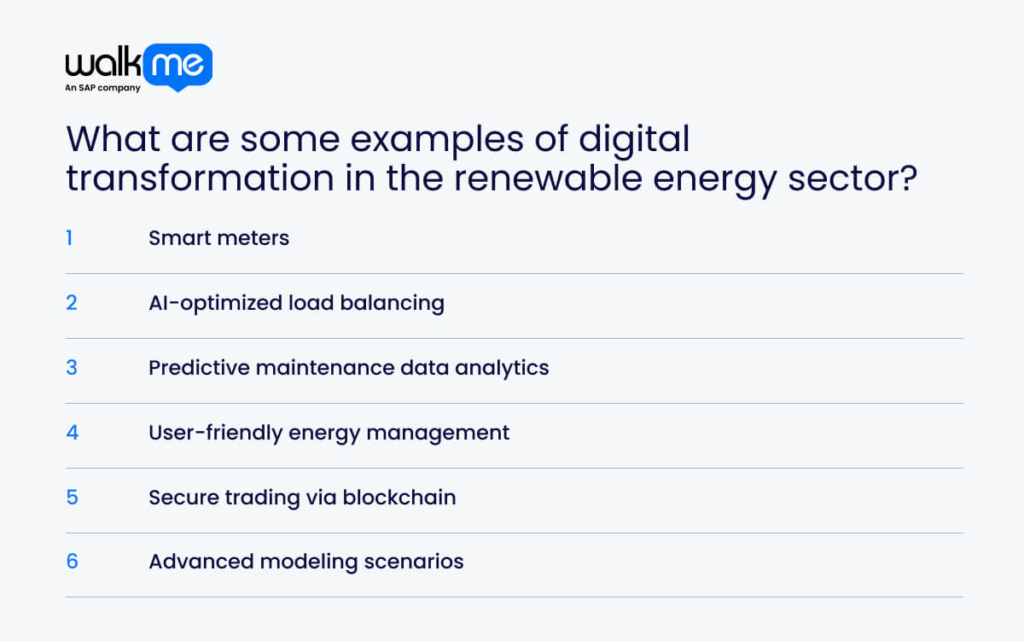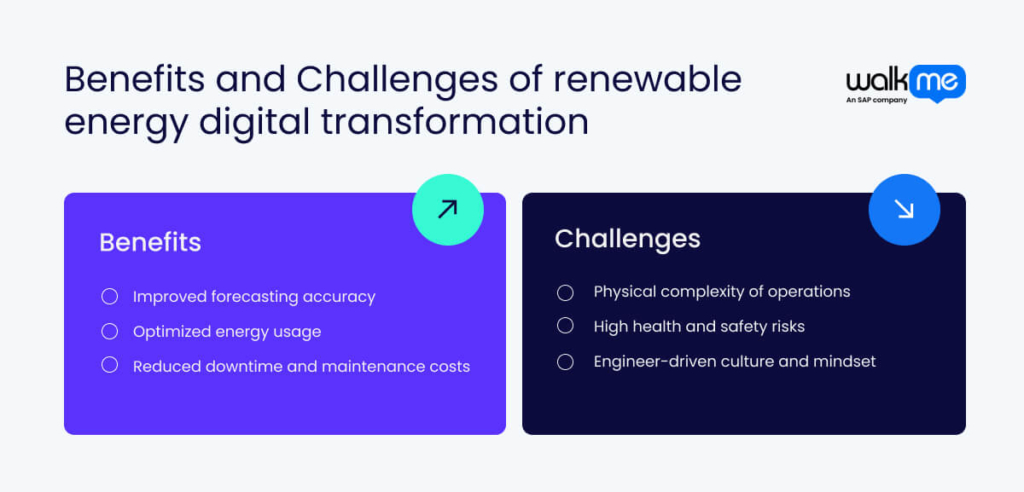Digital transformation in the renewable energy sector is closely tied to innovation and cost optimization.
However, adopting the latest technology alone won’t drive the deep, industry-wide cultural shift needed.
For change to take hold, the sector must also rethink its policies, technical standards, and digital transformation frameworks. This means moving past isolated upgrades to a more integrated, forward-looking approach.
Aligning innovation with smarter regulation and using cross-functional teams, renewable energy providers will be better equipped to take full advantage of emerging technologies and deliver cleaner, more reliable energy at scale.
This article explores how digital transformation is reshaping the renewable energy sector. It covers key technologies, real-world examples, benefits, and challenges driving a cleaner, smarter energy future.
What is renewable energy digital transformation?
Digital transformation in the renewable energy sector is the overhaul of internal systems, digital workflows, and guidelines that help the industry become more efficient, autonomous, and data-driven.
Renewable energy digital transformation seeks to use technology as a foundation to modernize operations, improve forecasting, and support smarter decision-making.
Digital transformation aligns technical upgrades with business and environmental goals when done right. For example, Xcel Energy uses AI-powered weather forecasting and digital twins to predict wind and solar output more accurately. Combined with cloud-based grid analytics, these tools help balance supply and demand while advancing its clean energy targets.
The shift to digital in renewable energy creates a more connected, responsive fuel ecosystem that can scale with future demand.
To really flourish, energy suppliers must look beyond isolated projects and embrace a sector-wide mindset metamorphosis grounded in interoperability, transparency, and process improvement methodologies.
Why is renewable energy digital transformation important?
Digital transformation is key for renewable energy to meet growing demand while reducing environmental impact.
Technologies like AI and edge computing help companies such as AES balance solar and wind power in real time, improving reliability for all users.
Digital twin technology allows better planning and less waste, making clean energy more affordable. Tools like predictive maintenance, such as Uptake, predict equipment failures, lower costs, and keep energy flowing.
These advances create a more resilient and accessible energy system that benefits diverse communities, including those historically underserved, ensuring everyone can share in a cleaner, more steadfast future.
What are some examples of digital transformation in the renewable energy sector?

Understanding digital transformation in renewable energy can feel complex. With technology evolving so quickly, staying informed means watching real-world examples to see how change happens.
Let’s take a look at some examples of digital transformation in the renewable energy sector:
Smart meters
Smart meters are probably the best-known entry on the list and track how much energy you use in real time. Utilities and households can spot waste and adjust quickly. In California, smart meters help shift usage during peak times, easing pressure on the grid. They also support solar and battery systems. In the future, they’ll link with smart home tech to make managing energy even easier and more reflexive.
AI-optimized load balancing
AI helps balance how energy is shared across the grid. It learns from patterns like weather or daily habits to predict demand. In New York, companies use AI to manage solar and wind power more efficiently. This keeps the supply steady and prevents blackouts. Over time, AI will help grids become faster, cleaner, and better at handling renewable energy sources.
Predictive maintenance data analytics
Turbines, solar panels, and other renewable energy machines can now tell us when they might break. Sensors collect data and flag problems early. General Electric uses this to fix wind turbines before they fail. It saves money and stops long delays, and as systems get smarter, repairs will happen faster, keeping clean energy flowing with less downtime and lower cost.
User-friendly energy management
Digital energy platforms now give users control over their usage, storage, and generation. Apps like Enphase show how much solar energy you produce, store, and export back to the grid. Utilities also offer dashboards for tracking time-of-use rates and managing peak demand. These tools help households and small businesses make smarter energy choices. Future platforms will focus on accessibility, automation, and integration with EVs and batteries.
Secure trading via blockchain
Blockchain lets people trade energy directly and safely, which has never been done before. For example, neighbors in Brooklyn sell each other extra solar power. This creates local, trusted markets without needing big companies in between. Blockchain also keeps records secure and transparent, meaning that as the technology grows, more communities will share clean energy, making power more local.
Advanced modeling scenarios
Advanced models test what could happen to the energy system under different conditions. The U.S. government’s NREL lab uses them to plan for storms, new tech, or policy changes. These models help leaders make smarter decisions. With better AI, the models will get more detailed and accurate. That means fewer surprises, and energy that’s clean, steady, and readily affordable.
Case studies for successful digital transformation in the renewable energy sector
Now that we’ve looked at some examples of digital transformation in the renewable energy sector, the next step is to examine case studies.
Doing so will help you see how digital tools and strategies work in real-world settings. You’ll discover what succeeds, what scales, and what others in the industry are learning from.
Each case highlights different approaches to innovation, from smart infrastructure to data-led decision-making.
Let’s take a closer look at some case studies for successful digital transformation in the renewable energy sector:
Cosmo Energy’s digitalization initiative
Cosmo Energy is modernizing its operations with Cognite Data Fusion and Domo. These tools give staff real-time access to performance data and enable remote monitoring using digital twins. The result is faster decisions, safer maintenance, and more efficient workflows. Japan’s Ministry of Economy recognized Cosmo’s digital shift as a national benchmark. It shows how legacy energy firms can become smarter, safer, and more sustainable.
IWB’s solar power analytics with ML
Swiss energy provider IWB uses machine learning to improve solar forecasting. Combining weather data with usage trends predicts how much energy solar panels will generate. That makes it easier to plan how much power is needed from other sources. This helps reduce waste, lower costs, and build a more stable power supply. It’s a strong example of how AI supports smarter clean energy systems.
INESC uses algorithms for weekly forecasts
INESC TEC, based in Portugal, builds smart forecasting models for renewable energy and sustainable development programs. These algorithms predict weekly power generation by analyzing weather and historical data. The goal is to help grid operators plan better and avoid energy shortages. It also supports the shift to renewables by making variable energy sources like solar and wind easier to manage. INESC’s work shows how smart data tools keep the lights on.
Google’s decarbonizing solutions
Google is backing clean energy, investing over $800 M in Intersect Power to build data centers near renewable plants. It also signed a geothermal deal in Taiwan, which could double the country’s geothermal output by 2029. These efforts support Google’s goal to run on 100% carbon-free energy, 24/7, by 2030 and set an example for other global tech companies.
Solar energy data collection and storage
Solar data platforms are transforming how energy is captured, stored, and optimized. Companies like Verdigris use embedded sensors and smart meters to collect real-time performance data across grids and buildings. That data is sent to the cloud and used to flag faults, reduce waste, and balance demand. It also helps users monitor their solar usage more easily. As grids grow more complex, this level of visibility is key to making solar energy smarter and more scalable.

What are the benefits of renewable energy digital transformation?
Now that you’re up to speed and understand real-world case studies of renewable energy digital transformation in action, it’s time to look at the benefits.
Doing so will give you a holistic view of the nuances, decision-making processes, and emerging priorities shaping the future of energy.
Let’s take a closer look at the benefits of renewable energy digital transformation:
Improved forecasting accuracy
Machine learning models trained on weather and grid data can now predict solar or wind output with far greater precision. This reduces reliance on backup systems and improves planning. Accurate forecasts help operators balance supply and demand, lowering grid stress and ensuring renewable energy is used efficiently.
Optimized energy usage
Digital platforms track consumption patterns across buildings, devices, and time. When inefficiencies appear in real time, utilities and consumers can shift usage to off-peak hours, add storage, or use microgrids. Optimized energy leads to more stable systems and smarter distribution of clean power on a large scale.
Reduced downtime and maintenance costs
Sensors in turbines and solar panels monitor equipment health nonstop. Instead of waiting for faults, operators get alerts before failures occur. This switch from reactive to predictive maintenance lengthens asset life, lowers repair costs, and keeps energy flowing steadily, even during extreme weather or changing conditions.
What are the challenges of renewable energy digital transformation?
Understanding the challenges of digital transformation is just as important as recognizing its benefits. Knowing what to expect makes you better equipped to respond quickly and effectively.
This matters even more in the energy sector, where speed, accuracy, and system reliability directly impact performance, policy goals, and public trust.
Let’s take a closer look at the benefits of renewable energy digital transformation:
Physical complexity of operations
Digital transformation often faces real-world limits. Infrastructure spread across oceans, deserts, or mountains needs more than software updates. It calls for site-specific, tailored strategies. Success comes from combining digital tools with the physical demands of energy production. Solutions must be practical, durable, and built on operational experience.
High health and safety risks
Adding digital tools in high-risk settings brings technical and human dangers. Safety standards are strict, and every change must put lives before deadlines. Balancing innovation and protection means designing systems that improve awareness. The goal is to reduce exposure and support real-time decisions where risks are always present.
Engineer-driven culture and mindset
The renewable sector values accuracy, planning, and proof, so digital change is a cultural shift. Teams need to be involved, trusted, trained, and empowered. Lasting success comes from combining deep expertise with agile thinking, not replacing one with the other.
The final step in learning about renewable energy digital transformation involves understanding how to navigate the challenges and opportunities of adopting new technologies in this field.
Let’s take a closer look at how to navigate renewable energy digital transformation:
Prepare your workforce
Upskilling must go together with technology upgrades. Involving technicians, engineers, and operators early ensures tools fit real-world needs. Training programs, given in steps, help teams gain confidence and use data well in their work.
Navigate regulations
Energy regulations change by country, region, and technology. Staying ahead means adding compliance training to the system design phase. Involving legal teams and auditors early avoids redoing work and speeds up deployment, especially across different areas.
Strengthen cybersecurity
Modern grids rely on connected systems, including everything from smart meters to remote tools. Protecting these needs requires more than firewalls. It means constant threat detection, different types of employee training, and system design that keeps critical parts safe from attacks.
Align profit and sustainability
Data visibility lets you track costs and environmental impact together. Predictive analytics can find energy waste and pollution spots, helping businesses cut losses and meet sustainable technology and ESG goals without losing money.
Break down transformation barriers
Resistance often comes from different priorities across departments. Creating shared KPIs across engineering, IT, and operations helps teams focus on results, not ownership. Starting with clear wins, like faster outage response, builds trust and opens the door for bigger changes.
What’s next for renewable energy digital transformation
Renewable energy has come a long way since the widespread introduction of wind turbines and hydroelectric power.
New technology is seen as a key to innovation. However, its success depends on how well the industry adapts and integrates these advances.
The energy industry must continue delivering value for customers and stakeholders by investing in green and renewable technologies that save money, time, and effort.
Most importantly, these investments should protect the environment for future generations. The choices made today will shape the world they inherit, and there is no room for delay.
To achieve real and lasting change, digital transformation must remain a top priority as the sector moves into the next century.
FAQs
AI looks at weather and past energy data to guess how much energy wind turbines and solar panels will produce each day. This helps energy companies plan, reduce wasted energy, and keep power steady even when the weather changes suddenly or is unpredictable.
Blockchain is a safe and clear way to record every energy trade. It helps stop cheating and mistakes, makes buying and selling energy faster, and lets small energy producers sell power directly to customers without needing middlemen or banks.
Energy companies teach workers simple steps on how to use new digital tools and understand data. They include technicians and operators early so that training fits real jobs. Workers feel confident and ready to use the latest technology to improve workflows.

